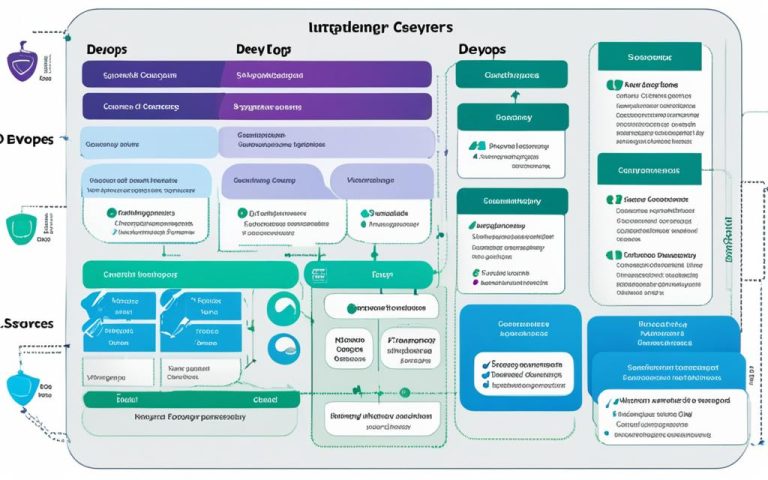Cloud storage has become a vital component of data management for organizations of all sizes. The ability to securely store and access data in the cloud offers numerous advantages, such as scalability, accessibility, and cost-effectiveness. However, managing and optimizing cloud storage for data science projects can be a complex task.
In this article, we will explore various tools that can help data scientists effectively manage and optimize their cloud storage and data workflows. Whether you are working with Azure, AWS, or GCP, there are powerful tools available to streamline your storage and data management processes.
We will begin by examining cloud storage management tools like Azure Blob Storage and Azure Data Blob Storage. These tools provide seamless integration, robust security features, and flexible storage options, making them ideal choices for data science projects. Additionally, we will explore other popular cloud storage management tools such as AWS Redshift, GCP’s BigQuery, and Azure’s Data Lake Storage. These tools form the backbone of modern data science across various cloud platforms.
By using these tools effectively, data scientists can optimize their data workflows, improve collaboration, and ensure the security and scalability of their cloud storage. In the following sections, we will delve deeper into the benefits of cloud storage for data science, factors to consider when choosing a cloud storage management tool, and real-world examples of tools widely used by data scientists.
Stay tuned to discover how you can make the most of cloud storage and data management tools to streamline your data science projects and drive innovation.
Why Cloud Storage for Data Science?
Cloud storage offers several advantages for data science, including the ability to handle large volumes of data without compromising performance or security. With cloud storage, data scientists can benefit from:
- Scalability: Cloud storage allows for the easy scaling of storage capacity as data needs grow, ensuring seamless access to data without limitations.
- Collaboration and Sharing: Cloud storage enables data scientists and stakeholders to collaborate and share data easily, enhancing teamwork and productivity.
- Integration: Cloud storage can integrate seamlessly with other cloud-based tools and platforms, providing a cohesive environment for data science workflows.
- Security: Cloud storage providers prioritize security and offer robust measures to protect data, including encryption, access controls, and compliance features.
- Support for Various Data Types: Cloud storage is capable of storing and managing different types of data, including structured, unstructured, and semi-structured data, catering to diverse data science requirements.
Azure Blob Storage is a notable cloud storage tool for data science. It provides seamless retrieval and integration with tools like AutoML, simplifying data workflows and enhancing efficiency. Additionally, other major cloud providers such as Google Cloud Platform (GCP) and Amazon Web Services (AWS) offer reliable and robust solutions for data science storage needs.
How to Choose a Cloud Storage Management Tool for Data Science?
When selecting a cloud storage management tool for data science, there are several important factors to consider. These include scalability, security, cost, integration capabilities, and compliance requirements. By carefully evaluating these factors, data scientists can choose a cloud storage management tool that best suits their specific needs and enables them to optimize their data workflow.
Scalability: It is crucial to choose a cloud storage management tool that can scale effortlessly as data volumes increase. This ensures that data scientists have the necessary storage capacity to handle their growing datasets without experiencing any performance issues. Tools like Amazon S3, Microsoft Azure Blob Storage, and Google Cloud Storage offer scalable solutions that can accommodate the evolving needs of data science projects.
Security: Data security is of utmost importance in any data science project. When choosing a cloud storage management tool, it is essential to prioritize security features such as encryption, access controls, and data protection protocols. Cloud storage platforms like Google Cloud Storage and IBM Cloud Object Storage offer robust security features that safeguard sensitive data throughout its lifecycle.
Cost: Cost-effectiveness is another critical consideration when selecting a cloud storage management tool. Data scientists need to evaluate the pricing models of different cloud storage platforms and choose a tool that aligns with their budget and cost expectations. Platforms such as Amazon S3 and Microsoft Azure Blob Storage provide flexible pricing options that can accommodate different data science project budgets.
Integration Capabilities: Seamless integration with other tools and platforms is essential for data scientists to streamline their workflows. When choosing a cloud storage management tool, it is important to assess its compatibility with other data science tools, such as analytics platforms, machine learning frameworks, and data processing frameworks. Databricks File System (DBFS) is an example of a tool that offers strong integration capabilities with popular data science tools.
Compliance Requirements: Depending on the industry and the nature of the data being managed, data scientists may have specific compliance requirements to adhere to. These requirements could include data privacy regulations, industry standards, or organizational policies. Cloud storage management tools like IBM Cloud Object Storage provide features that ensure compliance with relevant regulations and standards.
By considering the factors of scalability, security, cost, integration capabilities, and compliance requirements, data scientists can make an informed decision when choosing a cloud storage management tool for their data science projects. It is crucial to select a tool that not only meets their current needs but also provides room for growth and optimization.
Comparison of Cloud Storage Management Tools
| Cloud Storage Platform | Scalability | Security | Cost | Integration Capabilities | Compliance |
|---|---|---|---|---|---|
| Amazon S3 | Highly scalable | Strong security features, including encryption | Flexible pricing options | Seamless integration with various data science tools | Compliance with industry regulations |
| Microsoft Azure Blob Storage | Scalable storage solution | Robust security features | Flexible pricing options | Integration with Azure’s data ecosystem | Compliance with industry standards |
| Google Cloud Storage | Scalable and highly available | Advanced security features, including encryption | Cost-effective pricing options | Integration with Google Cloud Platform tools | Compliance with industry regulations |
| Databricks File System (DBFS) | Scalable and optimized for big data processing | Encryption and access controls | Free tier available with premium options | Tight integration with Databricks platform | Compliance with industry regulations |
| IBM Cloud Object Storage | Highly scalable, suitable for large datasets | Advanced data security measures | Flexible pricing options | Integration with IBM’s data and AI services | Compliance with industry regulations |

Being aware of the capabilities and features of different cloud storage management tools allows data scientists to make an informed decision that aligns with their specific requirements. Whether prioritizing scalability, security, cost-effectiveness, integration capabilities, or compliance, there are various options available in the market to meet the unique needs of data science projects.
Examples of Cloud Storage Management Tools for Data Science
Data scientists rely on various cloud storage management tools to store, organize, and analyze their data. Some popular options used by data scientists include Amazon S3, Google Drive, and Azure Data Lake Storage.
Amazon S3: Amazon S3 is a highly scalable and secure cloud storage service offered by Amazon Web Services. It provides data scientists with a range of features and functionalities to manage their data effectively. These features include:
Encryption: Amazon S3 offers server-side encryption to protect data at rest.
Versioning: With versioning, data scientists can track and restore different versions of their files, ensuring data integrity.
Lifecycle Management: Amazon S3 allows for automated data movement between storage classes based on user-defined rules, optimizing cost and performance.
Analytics: Data scientists can utilize Amazon S3’s analytics capabilities to gain insights into their data, enabling more informed decision-making.
Google Drive: Google Drive is a widely used cloud storage solution that offers high performance, security, and consistency. Data scientists can benefit from the following features:
Edge Caching: Google Drive includes edge caching, which improves access times and enhances performance.
Retention Policies: Data scientists can set retention policies to ensure data compliance and prevent accidental deletions.
Archival Storage: Google Drive provides options for long-term archival storage, allowing data scientists to store data for extended periods.
Azure Data Lake Storage: Azure Data Lake Storage is a key component of Microsoft Azure’s data analytics ecosystem. It offers high throughput, scalability, security, and a hierarchical namespace, providing the following benefits to data scientists:
High Throughput: Azure Data Lake Storage enables data scientists to process large volumes of data efficiently.
Scalability: It scales seamlessly to meet the growing needs of data scientists, ensuring optimal performance.
Security: Azure Data Lake Storage incorporates robust security measures to protect data from unauthorized access.
Hierarchical Namespace: The hierarchical namespace structure enhances data organization and allows for efficient data exploration.
These cloud storage management tools provide data scientists with the necessary capabilities to handle and analyze data effectively, ultimately driving innovation and insights in the field of data science.
Conclusion
Optimizing cloud storage management and data workflow is crucial for data science projects. Once a suitable cloud storage management tool has been chosen, implementing best practices is essential to ensure efficient storage, retrieval, and management of data.
One important aspect is utilizing metadata and tags to label and categorize data. This enables easier organization, searchability, and understanding of the data, facilitating efficient data workflow.
Another key practice is organizing data with partitions and buckets. Partitioning data based on specific criteria allows for faster querying and analysis, while using buckets ensures logical grouping of related data, simplifying data management.
In addition, compressing and encoding data can optimize storage capacity and reduce costs. By implementing compression algorithms and encoding techniques, data can be stored in a more space-efficient manner without compromising its quality or integrity.
Implementing encryption and access control measures is vital to ensure data security and compliance. Encryption techniques safeguard sensitive information, while access control mechanisms limit data access to authorized individuals or systems, protecting data integrity.
Monitoring and auditing data usage and activity play a significant role in optimizing data workflow. By tracking data access, modifications, and usage patterns, data scientists can identify inefficiencies, potential bottlenecks, and opportunities for improvement.
In conclusion, by implementing these best practices in cloud storage management, data scientists can optimize their data workflow, ensuring seamless storage, retrieval, and management of data. This not only improves efficiency but also enhances data security, compliance, and overall project success.
FAQ
What are the advantages of cloud storage for data science?
Cloud storage offers several advantages for data science, including the ability to handle large volumes of data without compromising performance or security, scalability according to needs, collaboration and sharing among data scientists and stakeholders, integration with other cloud-based tools and platforms, and support for various types of data.
Which cloud storage management tools are effective for data science?
Azure Blob Storage and Azure Data Blob Storage are effective cloud storage management tools for data science, providing seamless integration, robust security features, and flexible storage options. GCP’s BigQuery, AWS Redshift, and Azure’s Data Lake Storage are also examples of cloud storage management tools that form the backbone of modern data science across cloud platforms.
What factors should be considered when selecting a cloud storage management tool for data science?
When selecting a cloud storage management tool for data science, factors to consider include scalability, security, cost, integration capabilities, and compliance requirements. Platforms such as Amazon S3, Microsoft Azure Blob Storage, Google Cloud Storage, Databricks File System (DBFS), and IBM Cloud Object Storage offer solutions that meet specific needs.
Which cloud storage management tools are widely used by data scientists?
Amazon S3, Google Drive, and Azure Data Lake Storage are examples of cloud storage management tools widely used by data scientists. Amazon S3 offers features such as encryption, versioning, lifecycle management, and analytics. Google Cloud Storage provides high performance, security, and consistency, along with edge caching, retention policies, and archival storage. Azure Data Lake Storage offers high throughput, scalability, security, and a hierarchical namespace.
How can data workflow be optimized with cloud storage management tools?
Once a cloud storage management tool is chosen, optimizing data workflow can be achieved through best practices such as utilizing metadata and tags, organizing data with partitions and buckets, compressing and encoding data, implementing encryption and access control, and monitoring and auditing data usage and activity. By following these practices, data can be stored, retrieved, and managed effectively, ensuring an optimized data workflow for data science projects.



















